Analysis of Contemporary Accounting Issues: AASB Harmonization
VerifiedAdded on 2023/06/11
|13
|3644
|144
Essay
AI Summary
This essay explores contemporary accounting issues, particularly focusing on the Australian Accounting Standards Board's (AASB) efforts in international harmonization. It discusses the differences in financial reporting standards and the AASB's aim to work with international standard-setting boards like IASB and FASB to achieve a single set of global accounting standards, primarily through International Financial Reporting Standards (IFRS). The essay also addresses the challenges of harmonization and standardization, including economic and environmental factors, the role of developing countries, and the potential neglect of national standards. Finally, it applies institutional theory to explain the adoption and implementation of IFRS, emphasizing the importance of a unified approach to financial reporting in the global market. Desklib provides access to this and other solved assignments.
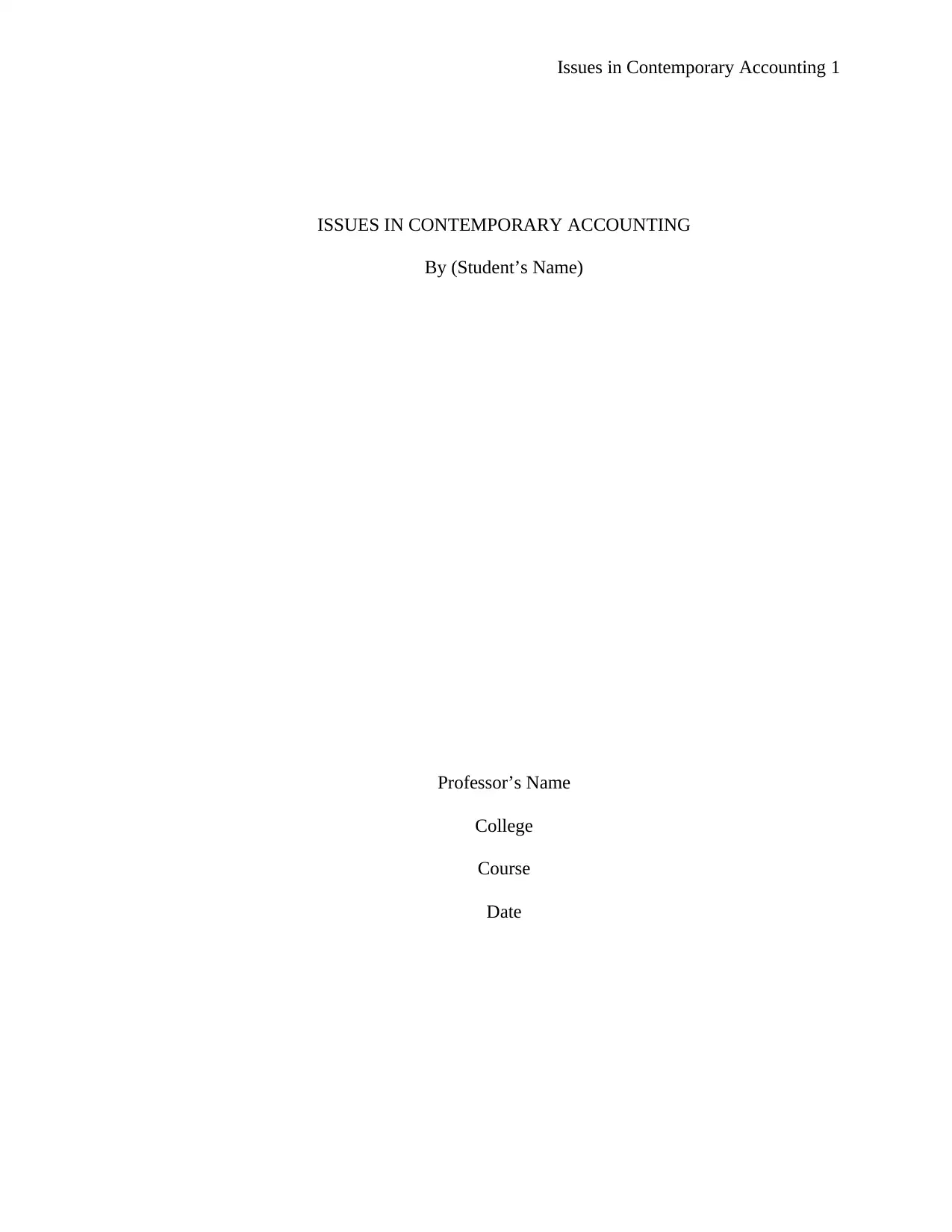
Issues in Contemporary Accounting 1
ISSUES IN CONTEMPORARY ACCOUNTING
By (Student’s Name)
Professor’s Name
College
Course
Date
ISSUES IN CONTEMPORARY ACCOUNTING
By (Student’s Name)
Professor’s Name
College
Course
Date
Paraphrase This Document
Need a fresh take? Get an instant paraphrase of this document with our AI Paraphraser
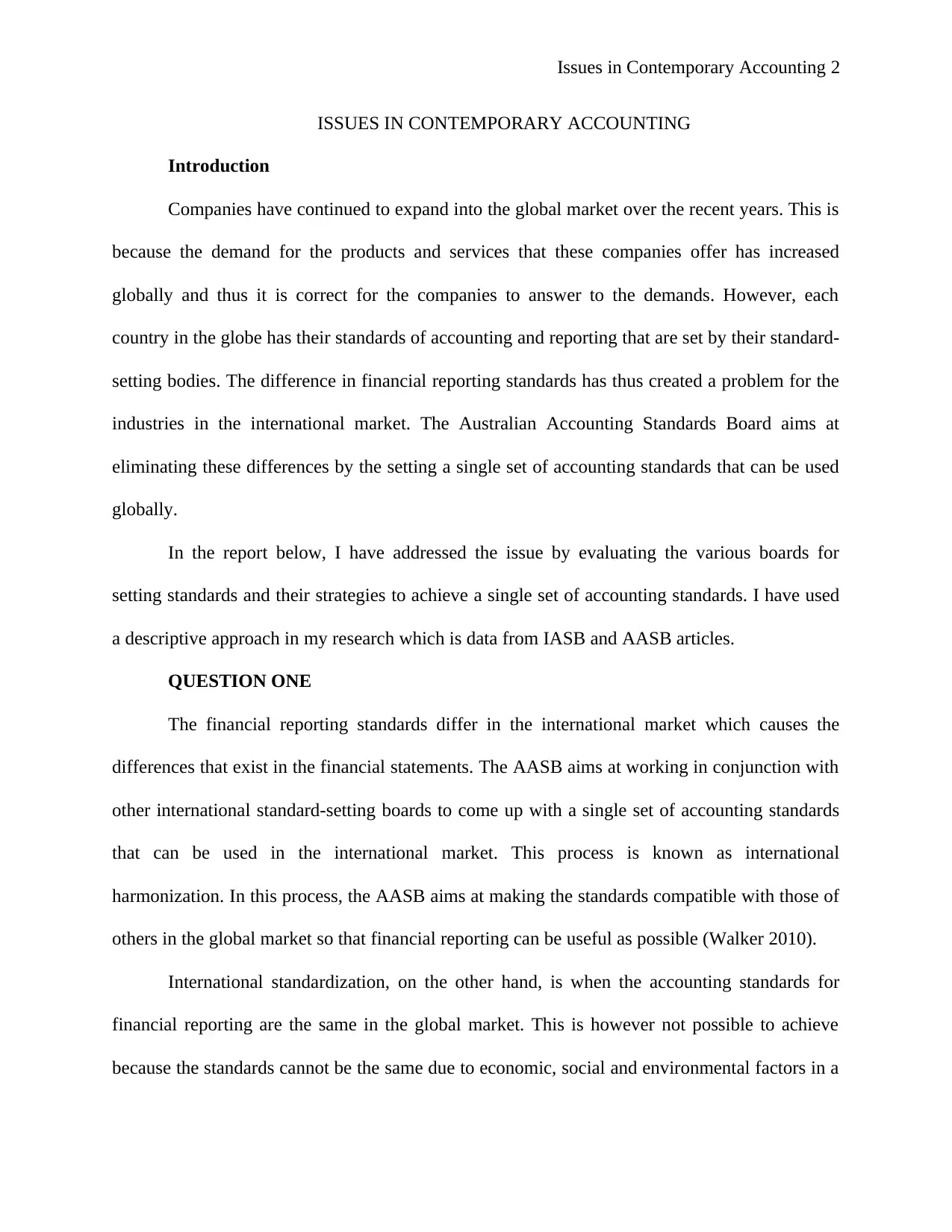
Issues in Contemporary Accounting 2
ISSUES IN CONTEMPORARY ACCOUNTING
Introduction
Companies have continued to expand into the global market over the recent years. This is
because the demand for the products and services that these companies offer has increased
globally and thus it is correct for the companies to answer to the demands. However, each
country in the globe has their standards of accounting and reporting that are set by their standard-
setting bodies. The difference in financial reporting standards has thus created a problem for the
industries in the international market. The Australian Accounting Standards Board aims at
eliminating these differences by the setting a single set of accounting standards that can be used
globally.
In the report below, I have addressed the issue by evaluating the various boards for
setting standards and their strategies to achieve a single set of accounting standards. I have used
a descriptive approach in my research which is data from IASB and AASB articles.
QUESTION ONE
The financial reporting standards differ in the international market which causes the
differences that exist in the financial statements. The AASB aims at working in conjunction with
other international standard-setting boards to come up with a single set of accounting standards
that can be used in the international market. This process is known as international
harmonization. In this process, the AASB aims at making the standards compatible with those of
others in the global market so that financial reporting can be useful as possible (Walker 2010).
International standardization, on the other hand, is when the accounting standards for
financial reporting are the same in the global market. This is however not possible to achieve
because the standards cannot be the same due to economic, social and environmental factors in a
ISSUES IN CONTEMPORARY ACCOUNTING
Introduction
Companies have continued to expand into the global market over the recent years. This is
because the demand for the products and services that these companies offer has increased
globally and thus it is correct for the companies to answer to the demands. However, each
country in the globe has their standards of accounting and reporting that are set by their standard-
setting bodies. The difference in financial reporting standards has thus created a problem for the
industries in the international market. The Australian Accounting Standards Board aims at
eliminating these differences by the setting a single set of accounting standards that can be used
globally.
In the report below, I have addressed the issue by evaluating the various boards for
setting standards and their strategies to achieve a single set of accounting standards. I have used
a descriptive approach in my research which is data from IASB and AASB articles.
QUESTION ONE
The financial reporting standards differ in the international market which causes the
differences that exist in the financial statements. The AASB aims at working in conjunction with
other international standard-setting boards to come up with a single set of accounting standards
that can be used in the international market. This process is known as international
harmonization. In this process, the AASB aims at making the standards compatible with those of
others in the global market so that financial reporting can be useful as possible (Walker 2010).
International standardization, on the other hand, is when the accounting standards for
financial reporting are the same in the global market. This is however not possible to achieve
because the standards cannot be the same due to economic, social and environmental factors in a
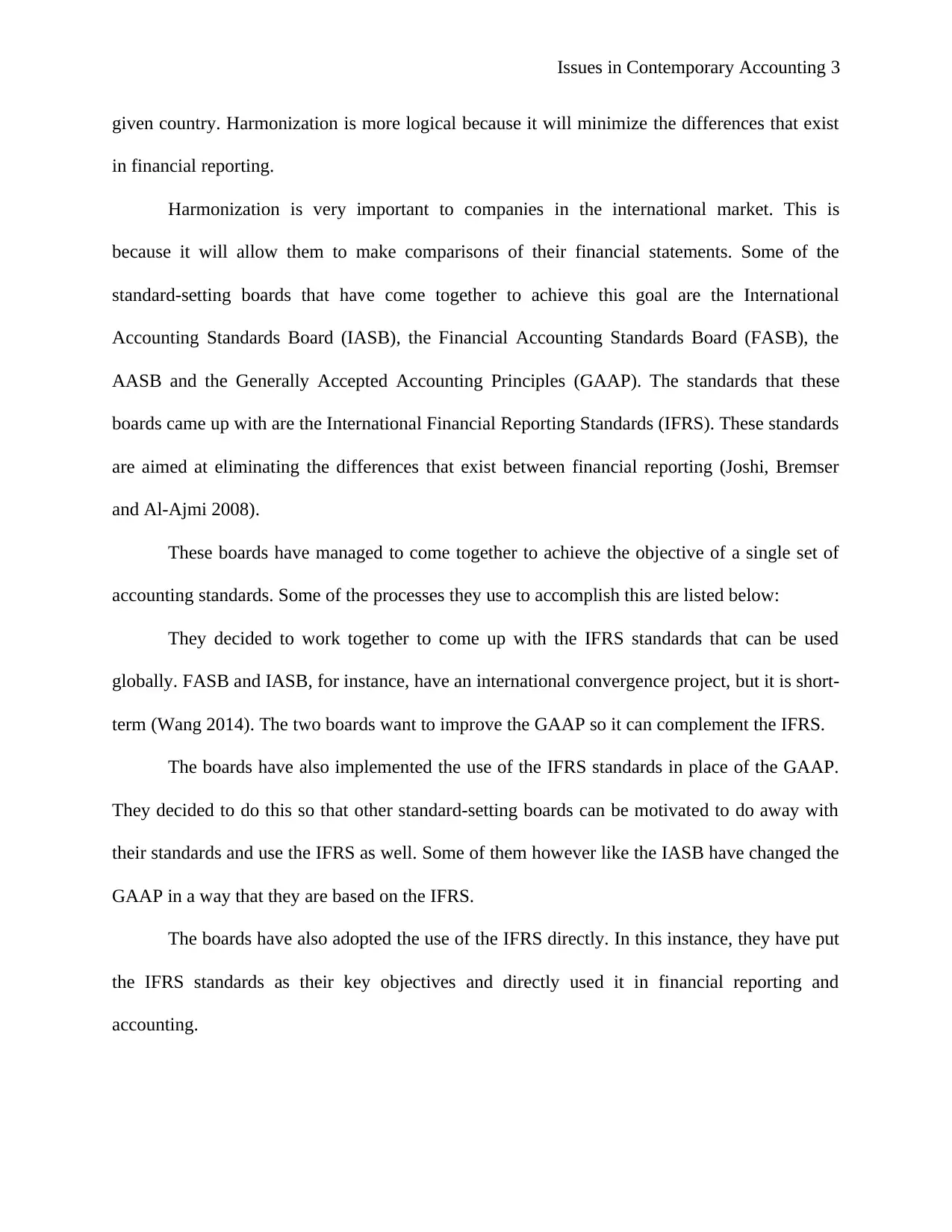
Issues in Contemporary Accounting 3
given country. Harmonization is more logical because it will minimize the differences that exist
in financial reporting.
Harmonization is very important to companies in the international market. This is
because it will allow them to make comparisons of their financial statements. Some of the
standard-setting boards that have come together to achieve this goal are the International
Accounting Standards Board (IASB), the Financial Accounting Standards Board (FASB), the
AASB and the Generally Accepted Accounting Principles (GAAP). The standards that these
boards came up with are the International Financial Reporting Standards (IFRS). These standards
are aimed at eliminating the differences that exist between financial reporting (Joshi, Bremser
and Al-Ajmi 2008).
These boards have managed to come together to achieve the objective of a single set of
accounting standards. Some of the processes they use to accomplish this are listed below:
They decided to work together to come up with the IFRS standards that can be used
globally. FASB and IASB, for instance, have an international convergence project, but it is short-
term (Wang 2014). The two boards want to improve the GAAP so it can complement the IFRS.
The boards have also implemented the use of the IFRS standards in place of the GAAP.
They decided to do this so that other standard-setting boards can be motivated to do away with
their standards and use the IFRS as well. Some of them however like the IASB have changed the
GAAP in a way that they are based on the IFRS.
The boards have also adopted the use of the IFRS directly. In this instance, they have put
the IFRS standards as their key objectives and directly used it in financial reporting and
accounting.
given country. Harmonization is more logical because it will minimize the differences that exist
in financial reporting.
Harmonization is very important to companies in the international market. This is
because it will allow them to make comparisons of their financial statements. Some of the
standard-setting boards that have come together to achieve this goal are the International
Accounting Standards Board (IASB), the Financial Accounting Standards Board (FASB), the
AASB and the Generally Accepted Accounting Principles (GAAP). The standards that these
boards came up with are the International Financial Reporting Standards (IFRS). These standards
are aimed at eliminating the differences that exist between financial reporting (Joshi, Bremser
and Al-Ajmi 2008).
These boards have managed to come together to achieve the objective of a single set of
accounting standards. Some of the processes they use to accomplish this are listed below:
They decided to work together to come up with the IFRS standards that can be used
globally. FASB and IASB, for instance, have an international convergence project, but it is short-
term (Wang 2014). The two boards want to improve the GAAP so it can complement the IFRS.
The boards have also implemented the use of the IFRS standards in place of the GAAP.
They decided to do this so that other standard-setting boards can be motivated to do away with
their standards and use the IFRS as well. Some of them however like the IASB have changed the
GAAP in a way that they are based on the IFRS.
The boards have also adopted the use of the IFRS directly. In this instance, they have put
the IFRS standards as their key objectives and directly used it in financial reporting and
accounting.
⊘ This is a preview!⊘
Do you want full access?
Subscribe today to unlock all pages.

Trusted by 1+ million students worldwide
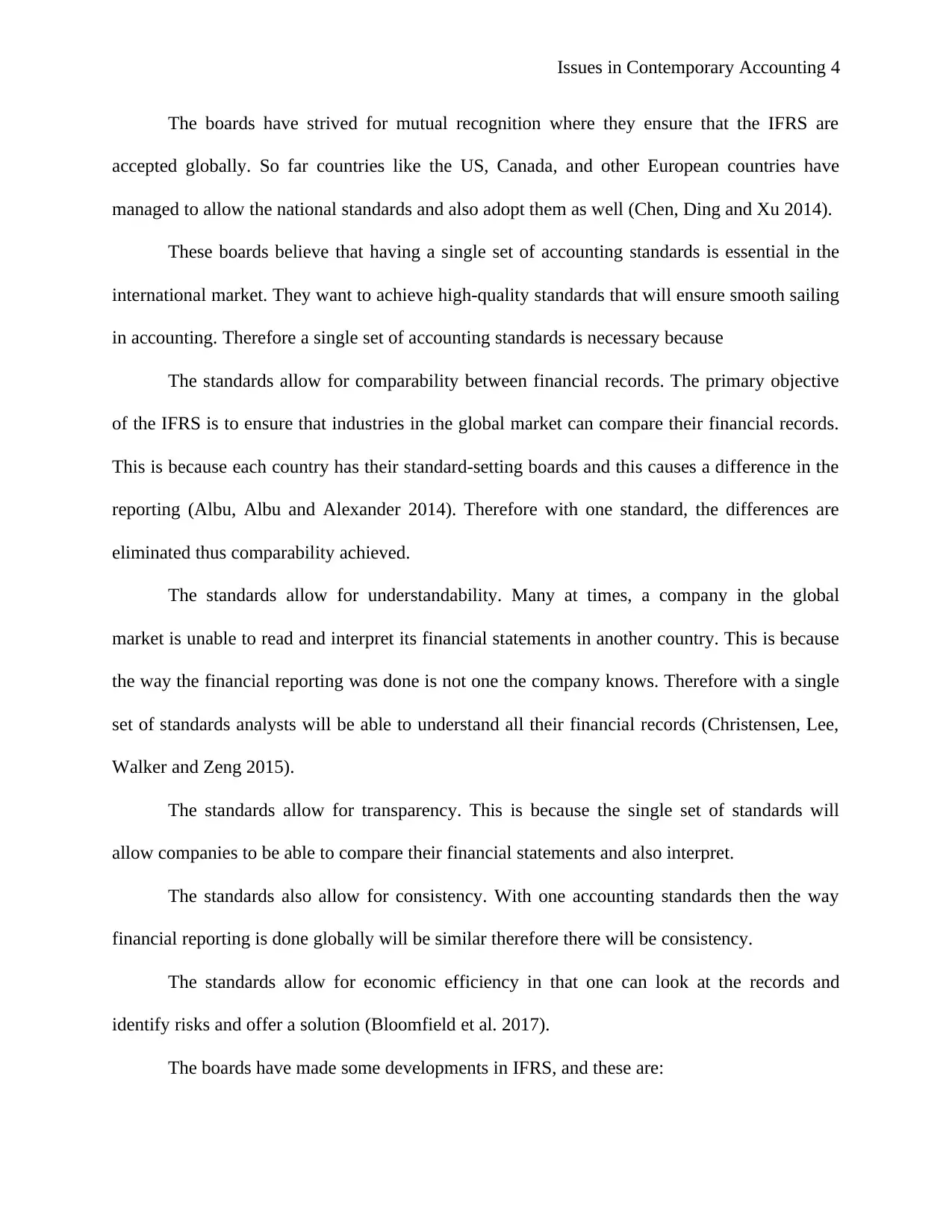
Issues in Contemporary Accounting 4
The boards have strived for mutual recognition where they ensure that the IFRS are
accepted globally. So far countries like the US, Canada, and other European countries have
managed to allow the national standards and also adopt them as well (Chen, Ding and Xu 2014).
These boards believe that having a single set of accounting standards is essential in the
international market. They want to achieve high-quality standards that will ensure smooth sailing
in accounting. Therefore a single set of accounting standards is necessary because
The standards allow for comparability between financial records. The primary objective
of the IFRS is to ensure that industries in the global market can compare their financial records.
This is because each country has their standard-setting boards and this causes a difference in the
reporting (Albu, Albu and Alexander 2014). Therefore with one standard, the differences are
eliminated thus comparability achieved.
The standards allow for understandability. Many at times, a company in the global
market is unable to read and interpret its financial statements in another country. This is because
the way the financial reporting was done is not one the company knows. Therefore with a single
set of standards analysts will be able to understand all their financial records (Christensen, Lee,
Walker and Zeng 2015).
The standards allow for transparency. This is because the single set of standards will
allow companies to be able to compare their financial statements and also interpret.
The standards also allow for consistency. With one accounting standards then the way
financial reporting is done globally will be similar therefore there will be consistency.
The standards allow for economic efficiency in that one can look at the records and
identify risks and offer a solution (Bloomfield et al. 2017).
The boards have made some developments in IFRS, and these are:
The boards have strived for mutual recognition where they ensure that the IFRS are
accepted globally. So far countries like the US, Canada, and other European countries have
managed to allow the national standards and also adopt them as well (Chen, Ding and Xu 2014).
These boards believe that having a single set of accounting standards is essential in the
international market. They want to achieve high-quality standards that will ensure smooth sailing
in accounting. Therefore a single set of accounting standards is necessary because
The standards allow for comparability between financial records. The primary objective
of the IFRS is to ensure that industries in the global market can compare their financial records.
This is because each country has their standard-setting boards and this causes a difference in the
reporting (Albu, Albu and Alexander 2014). Therefore with one standard, the differences are
eliminated thus comparability achieved.
The standards allow for understandability. Many at times, a company in the global
market is unable to read and interpret its financial statements in another country. This is because
the way the financial reporting was done is not one the company knows. Therefore with a single
set of standards analysts will be able to understand all their financial records (Christensen, Lee,
Walker and Zeng 2015).
The standards allow for transparency. This is because the single set of standards will
allow companies to be able to compare their financial statements and also interpret.
The standards also allow for consistency. With one accounting standards then the way
financial reporting is done globally will be similar therefore there will be consistency.
The standards allow for economic efficiency in that one can look at the records and
identify risks and offer a solution (Bloomfield et al. 2017).
The boards have made some developments in IFRS, and these are:
Paraphrase This Document
Need a fresh take? Get an instant paraphrase of this document with our AI Paraphraser
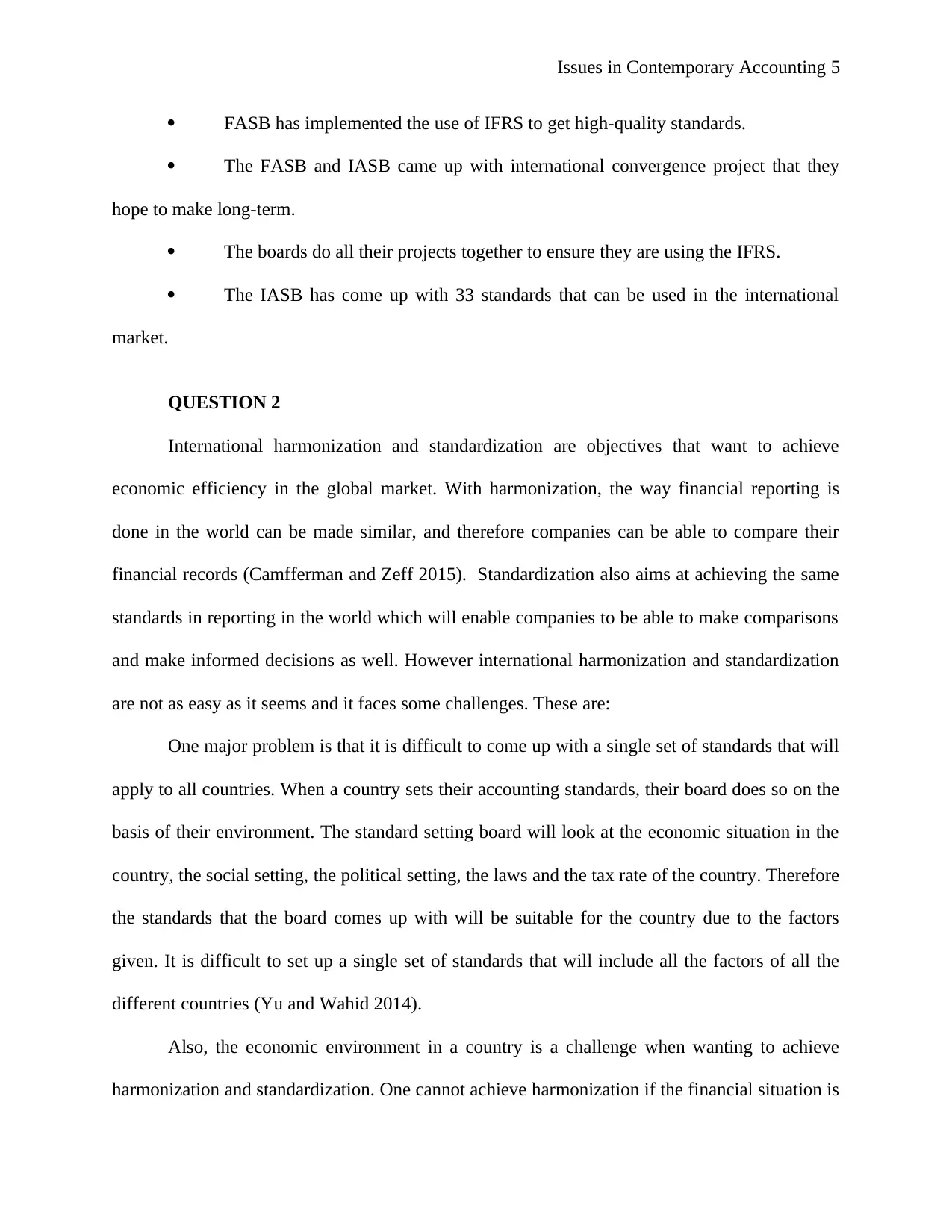
Issues in Contemporary Accounting 5
FASB has implemented the use of IFRS to get high-quality standards.
The FASB and IASB came up with international convergence project that they
hope to make long-term.
The boards do all their projects together to ensure they are using the IFRS.
The IASB has come up with 33 standards that can be used in the international
market.
QUESTION 2
International harmonization and standardization are objectives that want to achieve
economic efficiency in the global market. With harmonization, the way financial reporting is
done in the world can be made similar, and therefore companies can be able to compare their
financial records (Camfferman and Zeff 2015). Standardization also aims at achieving the same
standards in reporting in the world which will enable companies to be able to make comparisons
and make informed decisions as well. However international harmonization and standardization
are not as easy as it seems and it faces some challenges. These are:
One major problem is that it is difficult to come up with a single set of standards that will
apply to all countries. When a country sets their accounting standards, their board does so on the
basis of their environment. The standard setting board will look at the economic situation in the
country, the social setting, the political setting, the laws and the tax rate of the country. Therefore
the standards that the board comes up with will be suitable for the country due to the factors
given. It is difficult to set up a single set of standards that will include all the factors of all the
different countries (Yu and Wahid 2014).
Also, the economic environment in a country is a challenge when wanting to achieve
harmonization and standardization. One cannot achieve harmonization if the financial situation is
FASB has implemented the use of IFRS to get high-quality standards.
The FASB and IASB came up with international convergence project that they
hope to make long-term.
The boards do all their projects together to ensure they are using the IFRS.
The IASB has come up with 33 standards that can be used in the international
market.
QUESTION 2
International harmonization and standardization are objectives that want to achieve
economic efficiency in the global market. With harmonization, the way financial reporting is
done in the world can be made similar, and therefore companies can be able to compare their
financial records (Camfferman and Zeff 2015). Standardization also aims at achieving the same
standards in reporting in the world which will enable companies to be able to make comparisons
and make informed decisions as well. However international harmonization and standardization
are not as easy as it seems and it faces some challenges. These are:
One major problem is that it is difficult to come up with a single set of standards that will
apply to all countries. When a country sets their accounting standards, their board does so on the
basis of their environment. The standard setting board will look at the economic situation in the
country, the social setting, the political setting, the laws and the tax rate of the country. Therefore
the standards that the board comes up with will be suitable for the country due to the factors
given. It is difficult to set up a single set of standards that will include all the factors of all the
different countries (Yu and Wahid 2014).
Also, the economic environment in a country is a challenge when wanting to achieve
harmonization and standardization. One cannot achieve harmonization if the financial situation is
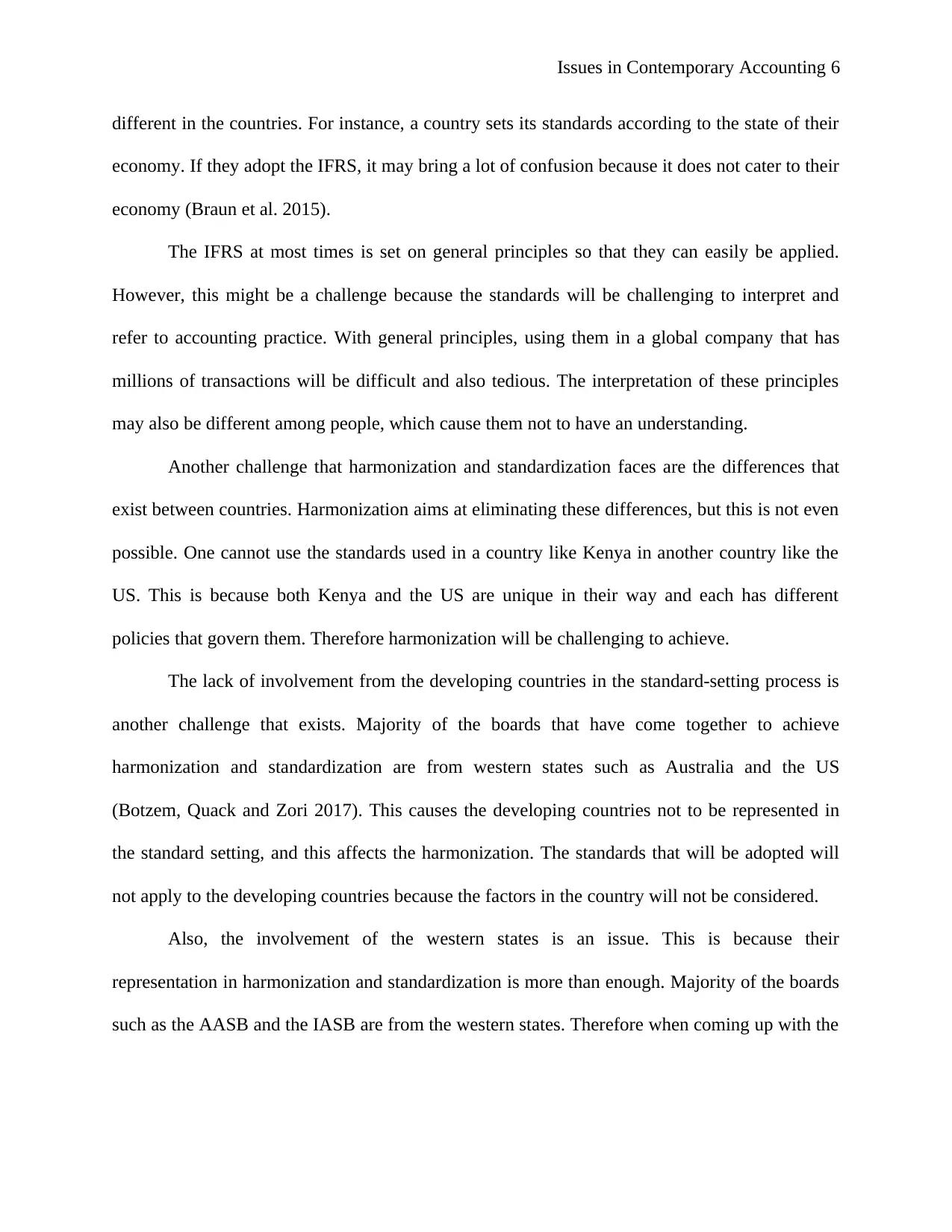
Issues in Contemporary Accounting 6
different in the countries. For instance, a country sets its standards according to the state of their
economy. If they adopt the IFRS, it may bring a lot of confusion because it does not cater to their
economy (Braun et al. 2015).
The IFRS at most times is set on general principles so that they can easily be applied.
However, this might be a challenge because the standards will be challenging to interpret and
refer to accounting practice. With general principles, using them in a global company that has
millions of transactions will be difficult and also tedious. The interpretation of these principles
may also be different among people, which cause them not to have an understanding.
Another challenge that harmonization and standardization faces are the differences that
exist between countries. Harmonization aims at eliminating these differences, but this is not even
possible. One cannot use the standards used in a country like Kenya in another country like the
US. This is because both Kenya and the US are unique in their way and each has different
policies that govern them. Therefore harmonization will be challenging to achieve.
The lack of involvement from the developing countries in the standard-setting process is
another challenge that exists. Majority of the boards that have come together to achieve
harmonization and standardization are from western states such as Australia and the US
(Botzem, Quack and Zori 2017). This causes the developing countries not to be represented in
the standard setting, and this affects the harmonization. The standards that will be adopted will
not apply to the developing countries because the factors in the country will not be considered.
Also, the involvement of the western states is an issue. This is because their
representation in harmonization and standardization is more than enough. Majority of the boards
such as the AASB and the IASB are from the western states. Therefore when coming up with the
different in the countries. For instance, a country sets its standards according to the state of their
economy. If they adopt the IFRS, it may bring a lot of confusion because it does not cater to their
economy (Braun et al. 2015).
The IFRS at most times is set on general principles so that they can easily be applied.
However, this might be a challenge because the standards will be challenging to interpret and
refer to accounting practice. With general principles, using them in a global company that has
millions of transactions will be difficult and also tedious. The interpretation of these principles
may also be different among people, which cause them not to have an understanding.
Another challenge that harmonization and standardization faces are the differences that
exist between countries. Harmonization aims at eliminating these differences, but this is not even
possible. One cannot use the standards used in a country like Kenya in another country like the
US. This is because both Kenya and the US are unique in their way and each has different
policies that govern them. Therefore harmonization will be challenging to achieve.
The lack of involvement from the developing countries in the standard-setting process is
another challenge that exists. Majority of the boards that have come together to achieve
harmonization and standardization are from western states such as Australia and the US
(Botzem, Quack and Zori 2017). This causes the developing countries not to be represented in
the standard setting, and this affects the harmonization. The standards that will be adopted will
not apply to the developing countries because the factors in the country will not be considered.
Also, the involvement of the western states is an issue. This is because their
representation in harmonization and standardization is more than enough. Majority of the boards
such as the AASB and the IASB are from the western states. Therefore when coming up with the
⊘ This is a preview!⊘
Do you want full access?
Subscribe today to unlock all pages.

Trusted by 1+ million students worldwide
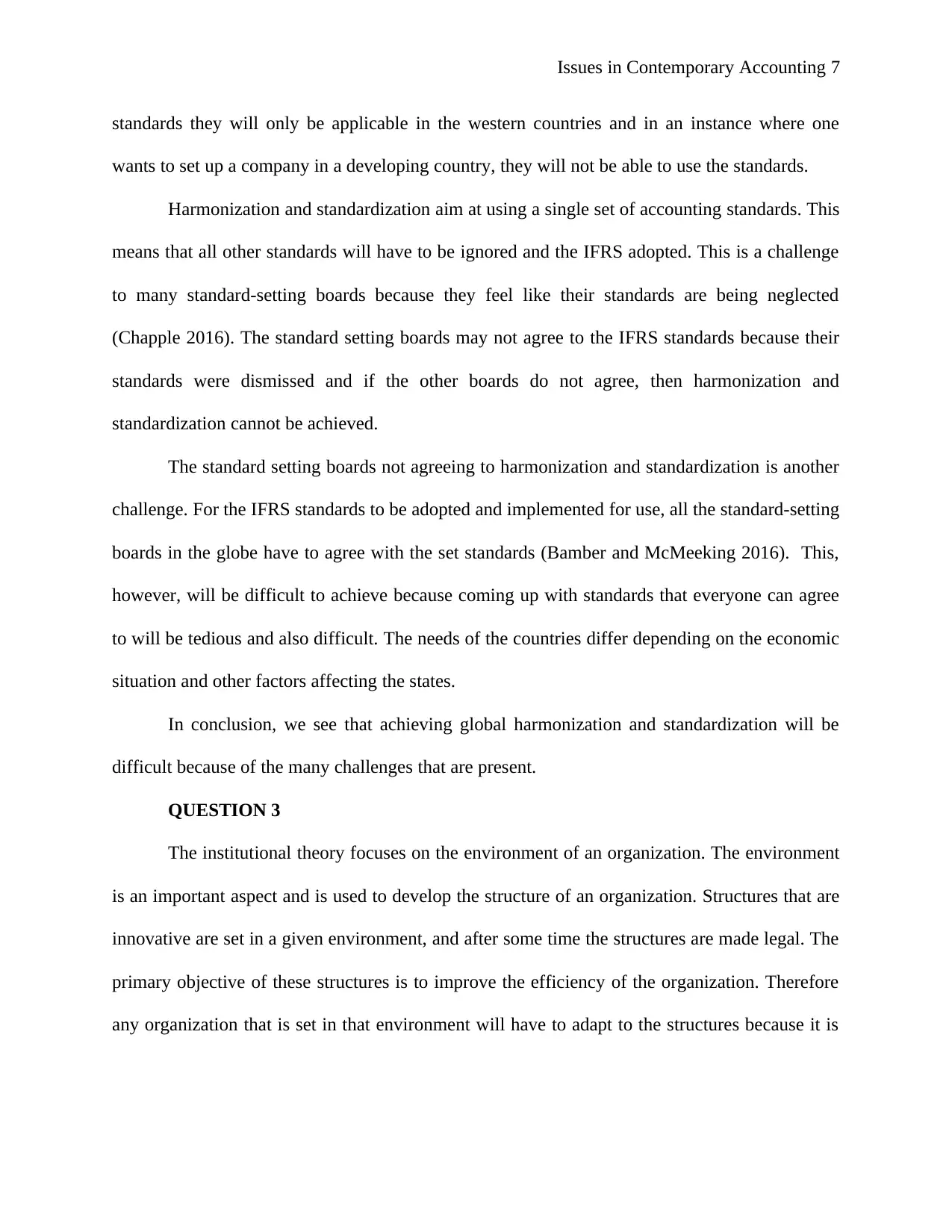
Issues in Contemporary Accounting 7
standards they will only be applicable in the western countries and in an instance where one
wants to set up a company in a developing country, they will not be able to use the standards.
Harmonization and standardization aim at using a single set of accounting standards. This
means that all other standards will have to be ignored and the IFRS adopted. This is a challenge
to many standard-setting boards because they feel like their standards are being neglected
(Chapple 2016). The standard setting boards may not agree to the IFRS standards because their
standards were dismissed and if the other boards do not agree, then harmonization and
standardization cannot be achieved.
The standard setting boards not agreeing to harmonization and standardization is another
challenge. For the IFRS standards to be adopted and implemented for use, all the standard-setting
boards in the globe have to agree with the set standards (Bamber and McMeeking 2016). This,
however, will be difficult to achieve because coming up with standards that everyone can agree
to will be tedious and also difficult. The needs of the countries differ depending on the economic
situation and other factors affecting the states.
In conclusion, we see that achieving global harmonization and standardization will be
difficult because of the many challenges that are present.
QUESTION 3
The institutional theory focuses on the environment of an organization. The environment
is an important aspect and is used to develop the structure of an organization. Structures that are
innovative are set in a given environment, and after some time the structures are made legal. The
primary objective of these structures is to improve the efficiency of the organization. Therefore
any organization that is set in that environment will have to adapt to the structures because it is
standards they will only be applicable in the western countries and in an instance where one
wants to set up a company in a developing country, they will not be able to use the standards.
Harmonization and standardization aim at using a single set of accounting standards. This
means that all other standards will have to be ignored and the IFRS adopted. This is a challenge
to many standard-setting boards because they feel like their standards are being neglected
(Chapple 2016). The standard setting boards may not agree to the IFRS standards because their
standards were dismissed and if the other boards do not agree, then harmonization and
standardization cannot be achieved.
The standard setting boards not agreeing to harmonization and standardization is another
challenge. For the IFRS standards to be adopted and implemented for use, all the standard-setting
boards in the globe have to agree with the set standards (Bamber and McMeeking 2016). This,
however, will be difficult to achieve because coming up with standards that everyone can agree
to will be tedious and also difficult. The needs of the countries differ depending on the economic
situation and other factors affecting the states.
In conclusion, we see that achieving global harmonization and standardization will be
difficult because of the many challenges that are present.
QUESTION 3
The institutional theory focuses on the environment of an organization. The environment
is an important aspect and is used to develop the structure of an organization. Structures that are
innovative are set in a given environment, and after some time the structures are made legal. The
primary objective of these structures is to improve the efficiency of the organization. Therefore
any organization that is set in that environment will have to adapt to the structures because it is
Paraphrase This Document
Need a fresh take? Get an instant paraphrase of this document with our AI Paraphraser
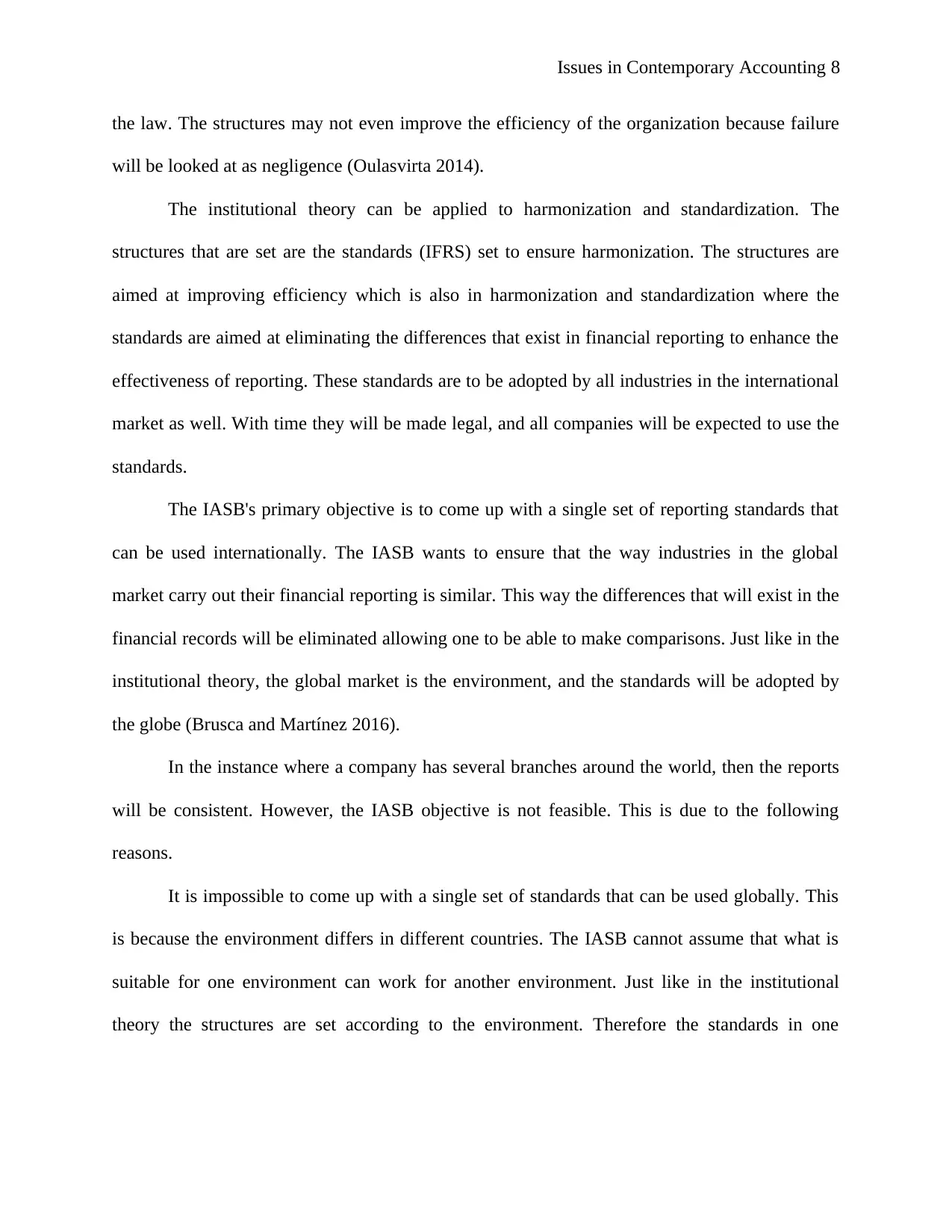
Issues in Contemporary Accounting 8
the law. The structures may not even improve the efficiency of the organization because failure
will be looked at as negligence (Oulasvirta 2014).
The institutional theory can be applied to harmonization and standardization. The
structures that are set are the standards (IFRS) set to ensure harmonization. The structures are
aimed at improving efficiency which is also in harmonization and standardization where the
standards are aimed at eliminating the differences that exist in financial reporting to enhance the
effectiveness of reporting. These standards are to be adopted by all industries in the international
market as well. With time they will be made legal, and all companies will be expected to use the
standards.
The IASB's primary objective is to come up with a single set of reporting standards that
can be used internationally. The IASB wants to ensure that the way industries in the global
market carry out their financial reporting is similar. This way the differences that will exist in the
financial records will be eliminated allowing one to be able to make comparisons. Just like in the
institutional theory, the global market is the environment, and the standards will be adopted by
the globe (Brusca and Martínez 2016).
In the instance where a company has several branches around the world, then the reports
will be consistent. However, the IASB objective is not feasible. This is due to the following
reasons.
It is impossible to come up with a single set of standards that can be used globally. This
is because the environment differs in different countries. The IASB cannot assume that what is
suitable for one environment can work for another environment. Just like in the institutional
theory the structures are set according to the environment. Therefore the standards in one
the law. The structures may not even improve the efficiency of the organization because failure
will be looked at as negligence (Oulasvirta 2014).
The institutional theory can be applied to harmonization and standardization. The
structures that are set are the standards (IFRS) set to ensure harmonization. The structures are
aimed at improving efficiency which is also in harmonization and standardization where the
standards are aimed at eliminating the differences that exist in financial reporting to enhance the
effectiveness of reporting. These standards are to be adopted by all industries in the international
market as well. With time they will be made legal, and all companies will be expected to use the
standards.
The IASB's primary objective is to come up with a single set of reporting standards that
can be used internationally. The IASB wants to ensure that the way industries in the global
market carry out their financial reporting is similar. This way the differences that will exist in the
financial records will be eliminated allowing one to be able to make comparisons. Just like in the
institutional theory, the global market is the environment, and the standards will be adopted by
the globe (Brusca and Martínez 2016).
In the instance where a company has several branches around the world, then the reports
will be consistent. However, the IASB objective is not feasible. This is due to the following
reasons.
It is impossible to come up with a single set of standards that can be used globally. This
is because the environment differs in different countries. The IASB cannot assume that what is
suitable for one environment can work for another environment. Just like in the institutional
theory the structures are set according to the environment. Therefore the standards in one
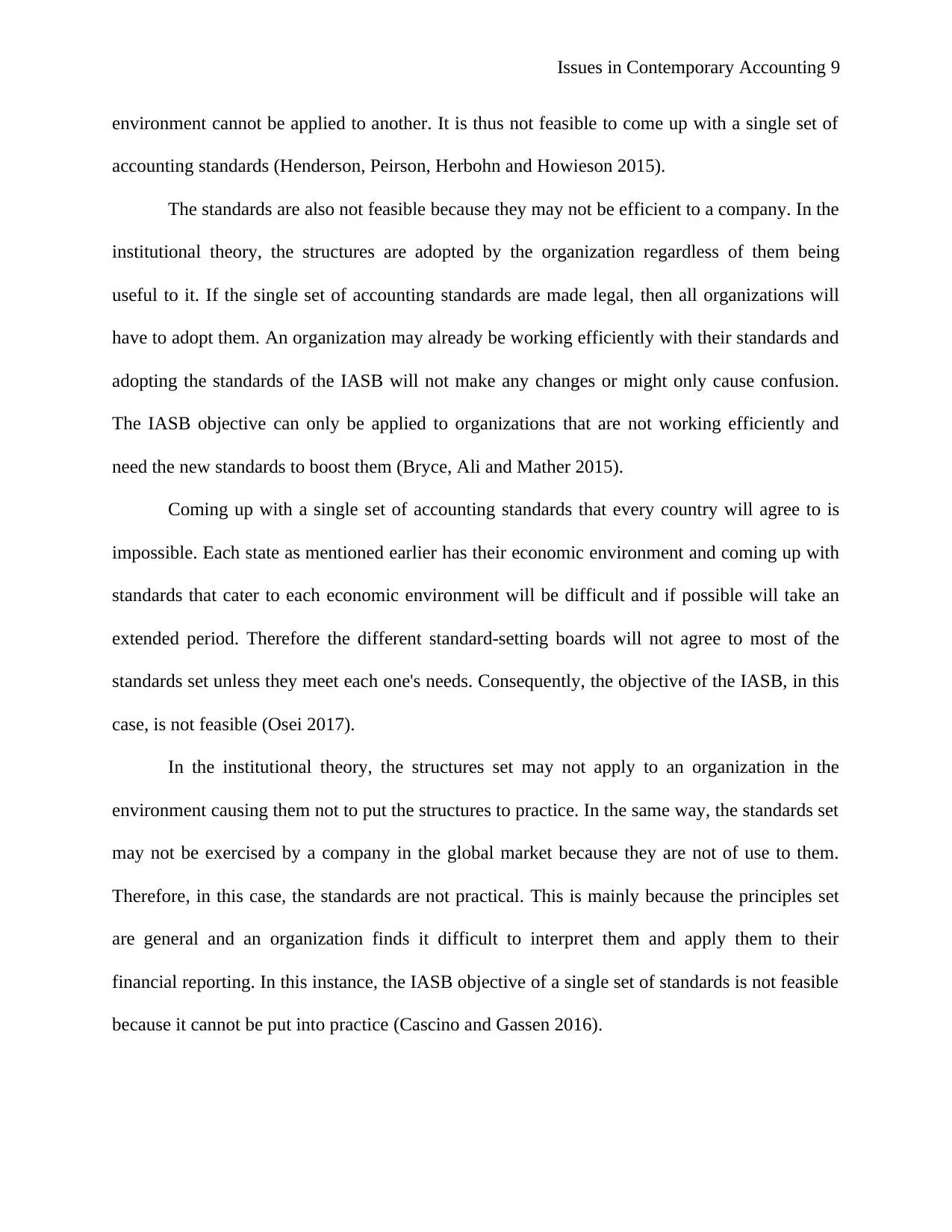
Issues in Contemporary Accounting 9
environment cannot be applied to another. It is thus not feasible to come up with a single set of
accounting standards (Henderson, Peirson, Herbohn and Howieson 2015).
The standards are also not feasible because they may not be efficient to a company. In the
institutional theory, the structures are adopted by the organization regardless of them being
useful to it. If the single set of accounting standards are made legal, then all organizations will
have to adopt them. An organization may already be working efficiently with their standards and
adopting the standards of the IASB will not make any changes or might only cause confusion.
The IASB objective can only be applied to organizations that are not working efficiently and
need the new standards to boost them (Bryce, Ali and Mather 2015).
Coming up with a single set of accounting standards that every country will agree to is
impossible. Each state as mentioned earlier has their economic environment and coming up with
standards that cater to each economic environment will be difficult and if possible will take an
extended period. Therefore the different standard-setting boards will not agree to most of the
standards set unless they meet each one's needs. Consequently, the objective of the IASB, in this
case, is not feasible (Osei 2017).
In the institutional theory, the structures set may not apply to an organization in the
environment causing them not to put the structures to practice. In the same way, the standards set
may not be exercised by a company in the global market because they are not of use to them.
Therefore, in this case, the standards are not practical. This is mainly because the principles set
are general and an organization finds it difficult to interpret them and apply them to their
financial reporting. In this instance, the IASB objective of a single set of standards is not feasible
because it cannot be put into practice (Cascino and Gassen 2016).
environment cannot be applied to another. It is thus not feasible to come up with a single set of
accounting standards (Henderson, Peirson, Herbohn and Howieson 2015).
The standards are also not feasible because they may not be efficient to a company. In the
institutional theory, the structures are adopted by the organization regardless of them being
useful to it. If the single set of accounting standards are made legal, then all organizations will
have to adopt them. An organization may already be working efficiently with their standards and
adopting the standards of the IASB will not make any changes or might only cause confusion.
The IASB objective can only be applied to organizations that are not working efficiently and
need the new standards to boost them (Bryce, Ali and Mather 2015).
Coming up with a single set of accounting standards that every country will agree to is
impossible. Each state as mentioned earlier has their economic environment and coming up with
standards that cater to each economic environment will be difficult and if possible will take an
extended period. Therefore the different standard-setting boards will not agree to most of the
standards set unless they meet each one's needs. Consequently, the objective of the IASB, in this
case, is not feasible (Osei 2017).
In the institutional theory, the structures set may not apply to an organization in the
environment causing them not to put the structures to practice. In the same way, the standards set
may not be exercised by a company in the global market because they are not of use to them.
Therefore, in this case, the standards are not practical. This is mainly because the principles set
are general and an organization finds it difficult to interpret them and apply them to their
financial reporting. In this instance, the IASB objective of a single set of standards is not feasible
because it cannot be put into practice (Cascino and Gassen 2016).
⊘ This is a preview!⊘
Do you want full access?
Subscribe today to unlock all pages.

Trusted by 1+ million students worldwide
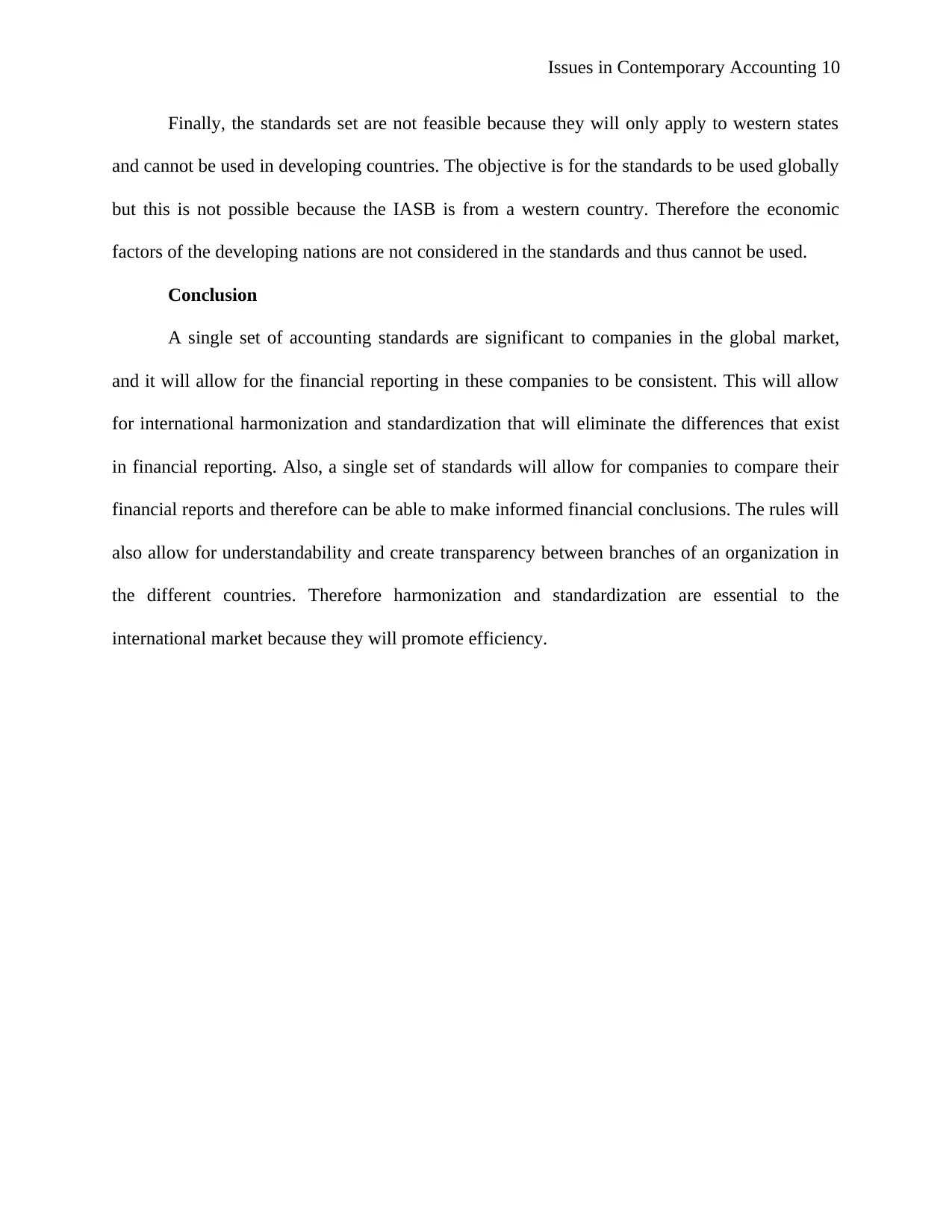
Issues in Contemporary Accounting 10
Finally, the standards set are not feasible because they will only apply to western states
and cannot be used in developing countries. The objective is for the standards to be used globally
but this is not possible because the IASB is from a western country. Therefore the economic
factors of the developing nations are not considered in the standards and thus cannot be used.
Conclusion
A single set of accounting standards are significant to companies in the global market,
and it will allow for the financial reporting in these companies to be consistent. This will allow
for international harmonization and standardization that will eliminate the differences that exist
in financial reporting. Also, a single set of standards will allow for companies to compare their
financial reports and therefore can be able to make informed financial conclusions. The rules will
also allow for understandability and create transparency between branches of an organization in
the different countries. Therefore harmonization and standardization are essential to the
international market because they will promote efficiency.
Finally, the standards set are not feasible because they will only apply to western states
and cannot be used in developing countries. The objective is for the standards to be used globally
but this is not possible because the IASB is from a western country. Therefore the economic
factors of the developing nations are not considered in the standards and thus cannot be used.
Conclusion
A single set of accounting standards are significant to companies in the global market,
and it will allow for the financial reporting in these companies to be consistent. This will allow
for international harmonization and standardization that will eliminate the differences that exist
in financial reporting. Also, a single set of standards will allow for companies to compare their
financial reports and therefore can be able to make informed financial conclusions. The rules will
also allow for understandability and create transparency between branches of an organization in
the different countries. Therefore harmonization and standardization are essential to the
international market because they will promote efficiency.
Paraphrase This Document
Need a fresh take? Get an instant paraphrase of this document with our AI Paraphraser
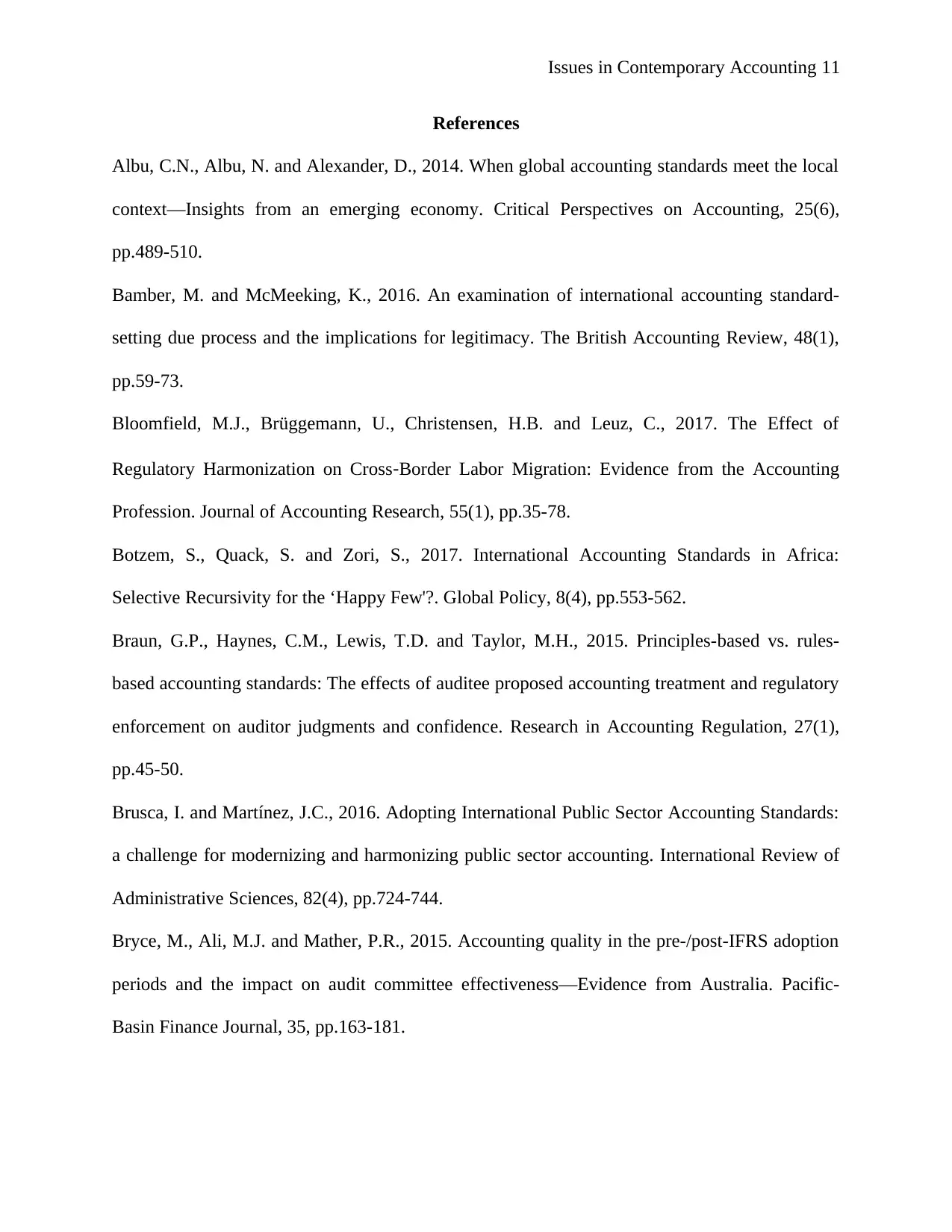
Issues in Contemporary Accounting 11
References
Albu, C.N., Albu, N. and Alexander, D., 2014. When global accounting standards meet the local
context—Insights from an emerging economy. Critical Perspectives on Accounting, 25(6),
pp.489-510.
Bamber, M. and McMeeking, K., 2016. An examination of international accounting standard-
setting due process and the implications for legitimacy. The British Accounting Review, 48(1),
pp.59-73.
Bloomfield, M.J., Brüggemann, U., Christensen, H.B. and Leuz, C., 2017. The Effect of
Regulatory Harmonization on Cross‐Border Labor Migration: Evidence from the Accounting
Profession. Journal of Accounting Research, 55(1), pp.35-78.
Botzem, S., Quack, S. and Zori, S., 2017. International Accounting Standards in Africa:
Selective Recursivity for the ‘Happy Few'?. Global Policy, 8(4), pp.553-562.
Braun, G.P., Haynes, C.M., Lewis, T.D. and Taylor, M.H., 2015. Principles-based vs. rules-
based accounting standards: The effects of auditee proposed accounting treatment and regulatory
enforcement on auditor judgments and confidence. Research in Accounting Regulation, 27(1),
pp.45-50.
Brusca, I. and Martínez, J.C., 2016. Adopting International Public Sector Accounting Standards:
a challenge for modernizing and harmonizing public sector accounting. International Review of
Administrative Sciences, 82(4), pp.724-744.
Bryce, M., Ali, M.J. and Mather, P.R., 2015. Accounting quality in the pre-/post-IFRS adoption
periods and the impact on audit committee effectiveness—Evidence from Australia. Pacific-
Basin Finance Journal, 35, pp.163-181.
References
Albu, C.N., Albu, N. and Alexander, D., 2014. When global accounting standards meet the local
context—Insights from an emerging economy. Critical Perspectives on Accounting, 25(6),
pp.489-510.
Bamber, M. and McMeeking, K., 2016. An examination of international accounting standard-
setting due process and the implications for legitimacy. The British Accounting Review, 48(1),
pp.59-73.
Bloomfield, M.J., Brüggemann, U., Christensen, H.B. and Leuz, C., 2017. The Effect of
Regulatory Harmonization on Cross‐Border Labor Migration: Evidence from the Accounting
Profession. Journal of Accounting Research, 55(1), pp.35-78.
Botzem, S., Quack, S. and Zori, S., 2017. International Accounting Standards in Africa:
Selective Recursivity for the ‘Happy Few'?. Global Policy, 8(4), pp.553-562.
Braun, G.P., Haynes, C.M., Lewis, T.D. and Taylor, M.H., 2015. Principles-based vs. rules-
based accounting standards: The effects of auditee proposed accounting treatment and regulatory
enforcement on auditor judgments and confidence. Research in Accounting Regulation, 27(1),
pp.45-50.
Brusca, I. and Martínez, J.C., 2016. Adopting International Public Sector Accounting Standards:
a challenge for modernizing and harmonizing public sector accounting. International Review of
Administrative Sciences, 82(4), pp.724-744.
Bryce, M., Ali, M.J. and Mather, P.R., 2015. Accounting quality in the pre-/post-IFRS adoption
periods and the impact on audit committee effectiveness—Evidence from Australia. Pacific-
Basin Finance Journal, 35, pp.163-181.
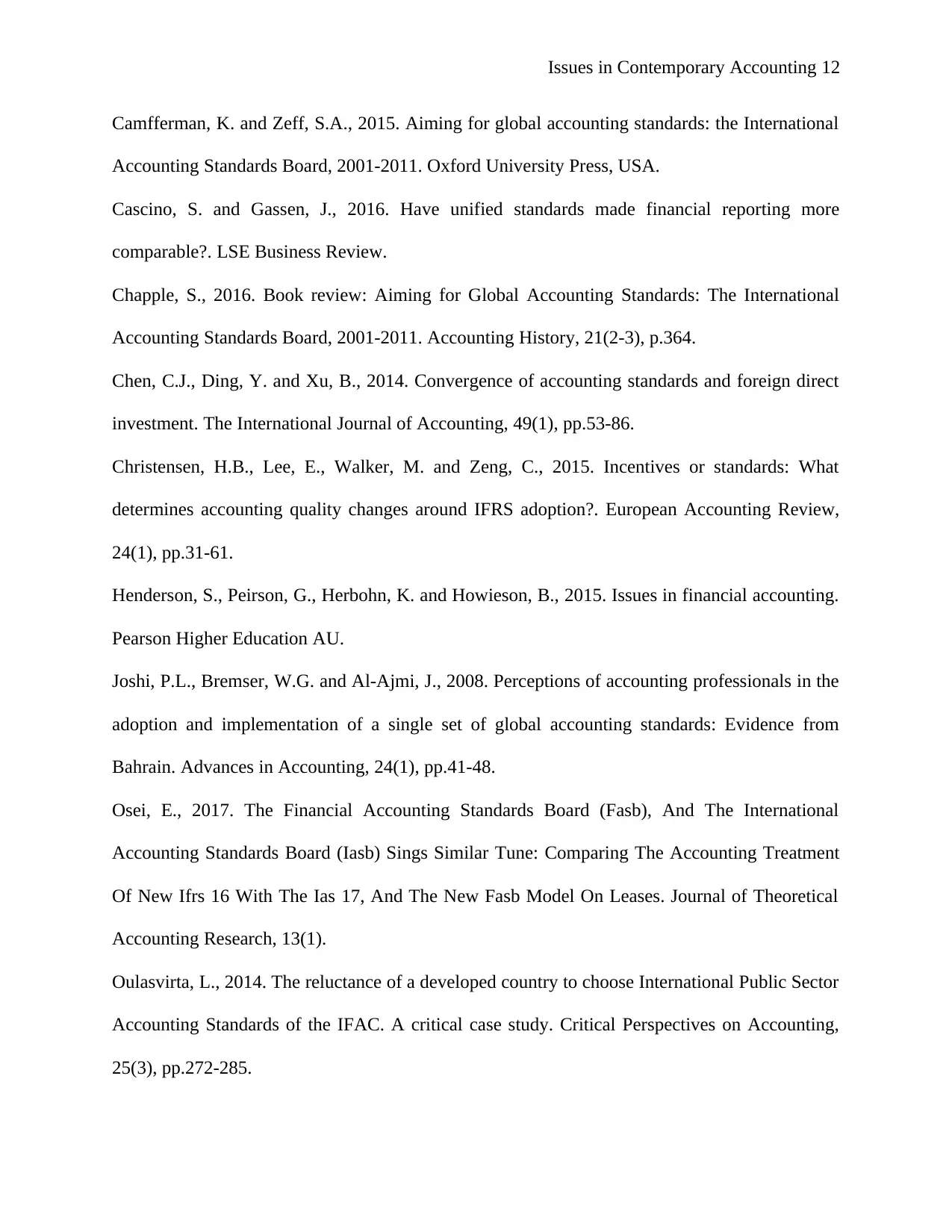
Issues in Contemporary Accounting 12
Camfferman, K. and Zeff, S.A., 2015. Aiming for global accounting standards: the International
Accounting Standards Board, 2001-2011. Oxford University Press, USA.
Cascino, S. and Gassen, J., 2016. Have unified standards made financial reporting more
comparable?. LSE Business Review.
Chapple, S., 2016. Book review: Aiming for Global Accounting Standards: The International
Accounting Standards Board, 2001-2011. Accounting History, 21(2-3), p.364.
Chen, C.J., Ding, Y. and Xu, B., 2014. Convergence of accounting standards and foreign direct
investment. The International Journal of Accounting, 49(1), pp.53-86.
Christensen, H.B., Lee, E., Walker, M. and Zeng, C., 2015. Incentives or standards: What
determines accounting quality changes around IFRS adoption?. European Accounting Review,
24(1), pp.31-61.
Henderson, S., Peirson, G., Herbohn, K. and Howieson, B., 2015. Issues in financial accounting.
Pearson Higher Education AU.
Joshi, P.L., Bremser, W.G. and Al-Ajmi, J., 2008. Perceptions of accounting professionals in the
adoption and implementation of a single set of global accounting standards: Evidence from
Bahrain. Advances in Accounting, 24(1), pp.41-48.
Osei, E., 2017. The Financial Accounting Standards Board (Fasb), And The International
Accounting Standards Board (Iasb) Sings Similar Tune: Comparing The Accounting Treatment
Of New Ifrs 16 With The Ias 17, And The New Fasb Model On Leases. Journal of Theoretical
Accounting Research, 13(1).
Oulasvirta, L., 2014. The reluctance of a developed country to choose International Public Sector
Accounting Standards of the IFAC. A critical case study. Critical Perspectives on Accounting,
25(3), pp.272-285.
Camfferman, K. and Zeff, S.A., 2015. Aiming for global accounting standards: the International
Accounting Standards Board, 2001-2011. Oxford University Press, USA.
Cascino, S. and Gassen, J., 2016. Have unified standards made financial reporting more
comparable?. LSE Business Review.
Chapple, S., 2016. Book review: Aiming for Global Accounting Standards: The International
Accounting Standards Board, 2001-2011. Accounting History, 21(2-3), p.364.
Chen, C.J., Ding, Y. and Xu, B., 2014. Convergence of accounting standards and foreign direct
investment. The International Journal of Accounting, 49(1), pp.53-86.
Christensen, H.B., Lee, E., Walker, M. and Zeng, C., 2015. Incentives or standards: What
determines accounting quality changes around IFRS adoption?. European Accounting Review,
24(1), pp.31-61.
Henderson, S., Peirson, G., Herbohn, K. and Howieson, B., 2015. Issues in financial accounting.
Pearson Higher Education AU.
Joshi, P.L., Bremser, W.G. and Al-Ajmi, J., 2008. Perceptions of accounting professionals in the
adoption and implementation of a single set of global accounting standards: Evidence from
Bahrain. Advances in Accounting, 24(1), pp.41-48.
Osei, E., 2017. The Financial Accounting Standards Board (Fasb), And The International
Accounting Standards Board (Iasb) Sings Similar Tune: Comparing The Accounting Treatment
Of New Ifrs 16 With The Ias 17, And The New Fasb Model On Leases. Journal of Theoretical
Accounting Research, 13(1).
Oulasvirta, L., 2014. The reluctance of a developed country to choose International Public Sector
Accounting Standards of the IFAC. A critical case study. Critical Perspectives on Accounting,
25(3), pp.272-285.
⊘ This is a preview!⊘
Do you want full access?
Subscribe today to unlock all pages.

Trusted by 1+ million students worldwide
1 out of 13
Related Documents
Your All-in-One AI-Powered Toolkit for Academic Success.
+13062052269
info@desklib.com
Available 24*7 on WhatsApp / Email
![[object Object]](/_next/static/media/star-bottom.7253800d.svg)
Unlock your academic potential
Copyright © 2020–2025 A2Z Services. All Rights Reserved. Developed and managed by ZUCOL.





